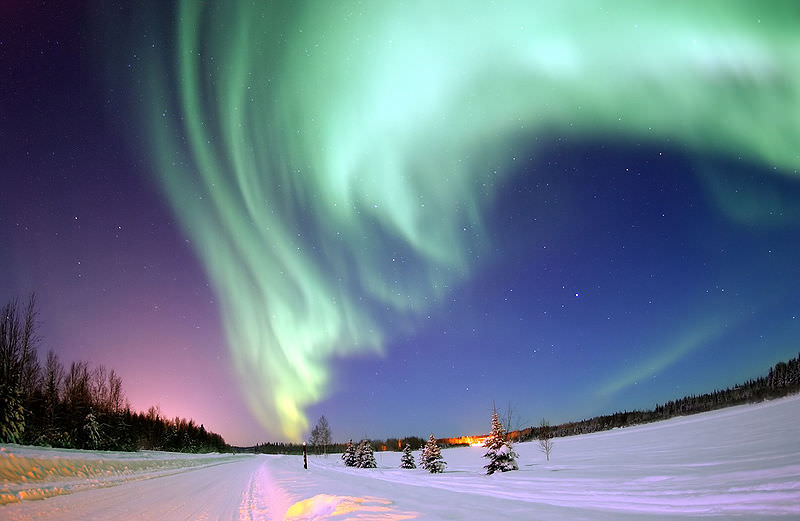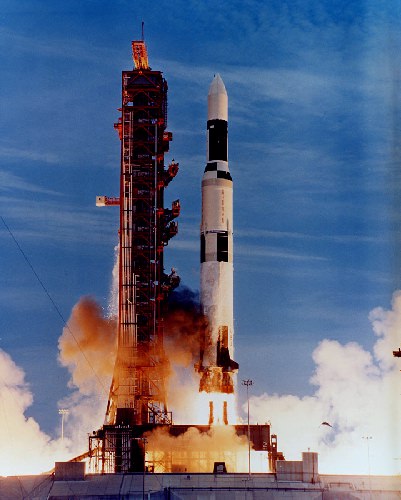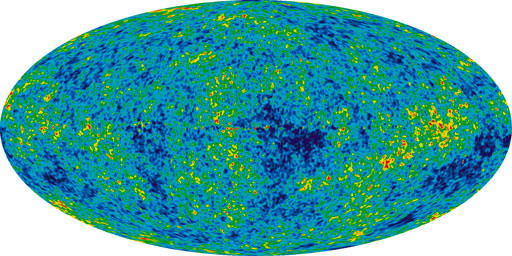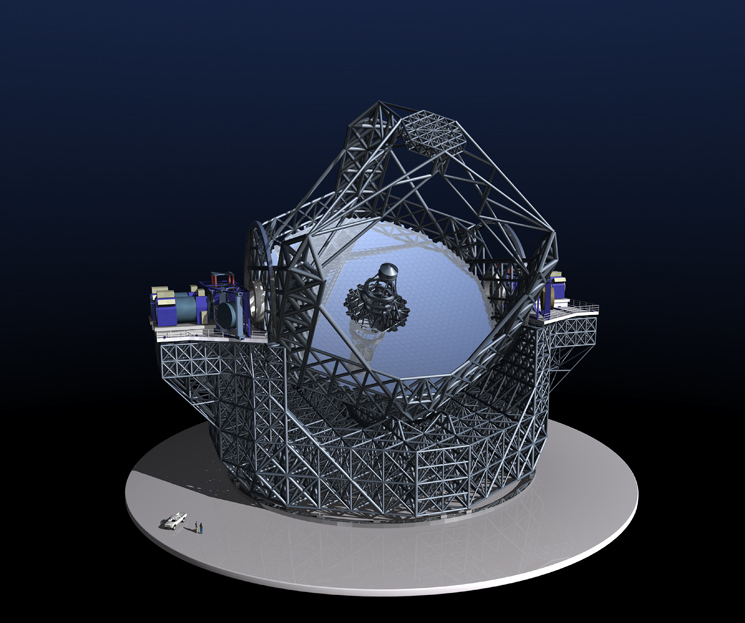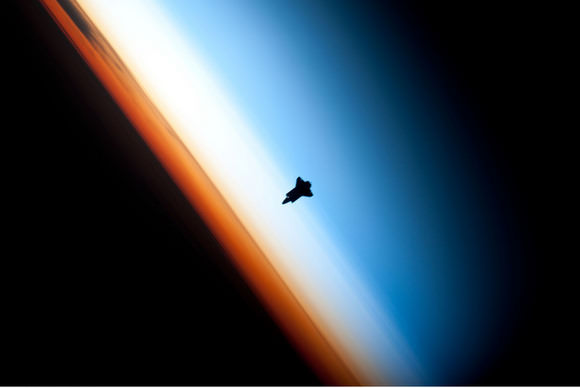This may be the last time we’ll see this. Launch videos taken from the space shuttle’s solid rocket boosters are incredible anyway, but add the fact the latest launch took place at night, and you’ve got a recipe for complete awesomeness! The SRB perspective of launch is unique, but go to about 2:05 in the video to watch the SRBs separate and you will swoon! Endeavour zooms away like something out of a science fiction movie. Then the sparks fly — literally and figuratively — as the SRBs fall away. Given STS-130 was the final scheduled night launch, don’t miss watching this one.
For Valentine’s Day: Hearts in Space from Sixty Symbols
Yes, we humans excel at seeing patterns and shapes everywhere around us, including out in space. Here, the folks from Sixty Symbols (featuring my friend Astropixie a.k.a Amanda Bauer) celebrate Valentine’s Day by showing several heart-shaped astronomical. Also, as explained in the video, 20 years ago today — on February 14, 1990 — the Voyager 1 spacecraft took the famous “Pale Blue Dot” image, where it turned around and took a picture of Earth. From 6 billion kilometers (4 billion miles) away Earth appeared as a “mote of dust suspended in a sunbeam” as Carl Sagan phrased it. It truly is one of the most “romantic” images ever as it can’t help but evoke strong emotions by anyone who sees it. “That’s here, that’s home, that’s us. On it everyone you love, everyone you know, everyone you ever heard of, every human being who ever was, lived out their lives,” said Sagan.
Continue reading “For Valentine’s Day: Hearts in Space from Sixty Symbols”
Aurora Watch! Valentine’s Day Sun-Earth Weather Alert
[/caption]
Sky watchers observing from high latitude areas may be in for a treat tonight. Forecasters from the National Oceanic and Atmospheric Administration have predicted a 30-35% chance of geo-magnetic storm activity during the late hours of February 14-15. Activity could reach as far south as Michigan, Minnesota, and Wisconsin. The source of this potential light show is a solar wind stream flowing energetically from a coronal hole on the Sun. If you’re lucky, the night sky where you live could look like this for Valentine’s Day night.

Coronal holes are darker, colder areas of the Sun’s corona that have lower-density plasma than elsewhere in the Sun’s outer atmosphere. Coronal holes are areas where the fast-moving component of the solar wind is known to pass through as it escapes into space.
When energy from the Sun interacts with the Earth’s outer atmosphere, it excites oxygen and nitrogen molecules some 100 and 400km above the surface, respectively, emitting a green (oxygen) or red (nitrogen) glow. This in turn excites observers on the ground, who may see the auroral dance take on any of several characteristic forms.
There may just be a glow to the north (or south if you live in the southern hemisphere), just over the horizon; or you may see arcs or bands of light, sometimes with vertical rays spiking high into the night sky. During strong events you may witness the famous curtain effect, or the coronal effect where all the rays appear to converge almost directly overhead.
So if the sky is clear tonight, take your Valentine outside, find a place to snuggle up and you may be rewarded with a light show you can share and remember for years to come.
Astronomy Without A Telescope – The Only Way Is Up
Escaping a gravity well is never an easy proposition. Unlike other kinds of wells there are no walls, so your options are ilimited. Over the years we humans have experimented with a variety of ways of getting out – with varying levels of success.
Trying to build your way out was first attempted – at least allegorically – with the Tower of Babel which (again allegorically) did not go well. Even with today’s engineering, it remains a dubious prospect. The relatively new Burj Khalifa in Dubai has managed to scale only 830 metres. The official defintition of where ‘space’ starts is 100 kilometres (or 60 miles).
Firing yourself out of a cannon or strapping explosives to your throne in the case of Wàn Hù, generally described as a minor official of the Ming Dynasty circa 1500, is similarly fraught with problems. See the Mythbusters episode Ming Dynasty Astronaut to see how that worked out.
Even if you do survive the initial blast, the huge acceleration required to achieve a projectile escape velocity of 11.2 kilometers a second from sea level will kill you anyway. And there’s also an issue of atmospheric drag – since the air in front of you will be superheated, your already Gforce-demised self will get cremated on the way up.
It would all be so much easier if someone could just throw down a rope. Various people have been attributed with first thinking up the space elevator – but it was probably Konstantin Tsiolkovsky – involving getting a base station into geostationary orbit and then lowering down from it kilometre-lengths of a carbon nanotube cable that we’ll be inventing any day now.
So for the moment at least, we are stuck with good old-fashioned rockets – for which we can also thank Mr Tsiolkovsky, amongst others. Although achieving a zero to 11.2 kilometers a second velocity at sea level will kill you – if you can get a bit of altitude at a lower acceleration rate, the escape velocity from that altitude will be lower. So as long as you can launch with enough fuel to keep gaining altitude, you can keep on applying this logic until you eventually escape the gravity well. We’ve done it with robotic spacecraft, but we’ve never done it with people.
Before I start sounding like a Moon landing denier, remember the Moon is still orbiting within Earth’s gravity well. Lagrange points 1 and 2, about 1.5 million kilometres away mark the edges of the Earth’s gravity well. L2 is perhaps the better target since you could use the Earth’s shadow to reduce your exposure to solar radiation. At 1.5 million kilometers, it’s about four times the distance to the Moon, so a one month round trip maybe. It’s still challenging and you’ll still collect a hit from cosmic rays – but nothing like the potentially suicidal two year round trip to Mars. So, if we can get past this obsession with landing on things, wouldn’t it be a wothwhile goal to try and finally get someone out of the well?
This Week in Space with Miles O’Brien, Edition #6
Miles O’Brien and the TWIS team cover the news from this past week, including the shuttle launch and the ongoing debate about NASA’s proposed 2011 budget.
Cosmological Constant
[/caption]
The cosmological constant, symbol Λ (Greek capital lambda), was ‘invented’ by Einstein, not long after he published his theory of general relativity (GR). It appears on the left-hand side of the Einstein field equations.
Einstein added this term because he – along with all other astronomers and physicists of the time – thought the universe was static (the cosmological constant can make a universe filled with mass-energy static, neither expanding nor contracting). However, he very quickly realized that this wouldn’t work, because such a universe would be unstable … and quickly turn into one either expanding or contracting! Not long afterwards, Hubble (actually Vesto Slipher) discovered that the universe is, in fact, expanding, so the need for a cosmological constant went away.
Until 1998.
In that year, two teams of astronomers independently announced that distant Type Ia supernovae did not have the apparent luminosity they should, in a universe composed almost entirely of mass-energy in the form of baryons (ordinary matter) and cold dark matter.
Dark Energy had been discovered: dark energy is a form of mass-energy that has a constant density throughout the universe, and perhaps throughout time as well; counter-intuitively, it causes the expansion of the universe to accelerate (i.e. it acts kinda like anti-gravity). The most natural form of dark energy is the cosmological constant.
A great deal of research has gone into trying to discover if dark energy is, in fact, just the cosmological constant, or if it is quintessence, or something else. So far, results from observations of the CMB (by WMAP, mainly), of BAO (baryon acoustic oscillations, by extensive surveys of galaxies), and of high-redshift supernovae (by many teams) are consistent with dark energy being the cosmological constant.
So if the cosmological constant is (a) mass-energy (density), it can be expressed as kilograms (per cubic meter), can’t it? Yes, and the best estimate today is 7.3 x 10-27 kg m 3.
Ned Wright’s Cosmology Tutorial (UCLA) and Sean Carroll’s Cosmology Primer (California Institute of Technology) between them cover not only the cosmological constant, but also cosmology! NASA’s What Is A Cosmological Constant? is a great one-page intro.
Universe Today has many, many stories featuring the cosmological constant! Here are a few to whet your appetite: Universe to WMAP: LCDM Rules, OK?, Einstein’s Cosmological Constant Predicts Dark Energy, and No “Big Rip” in our Future: Chandra Provides Insights Into Dark Energy.
There are many Astronomy Cast episodes which include discussion of the cosmological constant … these are among the best: The Big Bang and Cosmic Microwave Background, The Important Numbers in the Universe, and the March 18th, 2009 Questions Show.
Sources:
http://map.gsfc.nasa.gov/universe/uni_accel.html
http://super.colorado.edu/~michaele/Lambda/lambda.html
http://en.wikipedia.org/wiki/Cosmological_constant
Armazones Chile to be the Site for the 42 meter European Extremely Large Telescope?
Question: Where are the night skies always dark, cloud-free 360 days a year, bone-dry, and orbiting 3.5 km above sea level?
Answer: Armazones Mountain, Atacama desert, Chile.
Question: Who wants to go live there?
Answer: The European Extremely-Large Telescope (E-ELT)!
“We are talking about the biggest telescope in the world, the biggest for a long time to come. That means we have to choose the best spot. Chile has a superb location. It’s the best in the world, there’s no doubt,” the European Southern Observatory’s astronomer, Massimo Tarenghi, told AFP. He is one of four astronomers – two Chileans, an Italian (Tarenghi) and a German – who were in the desert this week to evaluate its suitability compared to the main other contender: the Spanish isle of La Palma in the Canary Islands off western Africa.
The European Southern Observatory (ESO), an intergovernmental astronomical research agency that already has three facilities operating in the Atacama desert, including the Very Large Telescope array in the town of Paranal which is currently considered Europe’s foremost observatory.
Work on the E-ELT is to begin in December 2011 and cost 90 million euros (120 million dollars) … once a decision is made on the site, which will be as early as March this year.
When complete, the E-ELT will be “the world’s biggest eye on the sky,” according to the ESO, which hopes it will “address many of the most pressing unsolved questions in astronomy.”
The E-ELT is likely to be as revolutionary in the field of astronomy as Galileo’s telescope 400 years ago that determined that the Sun, and not the Earth, was the center of our universe, according to the European agency based in Munich, Germany. The German astronomer in Chile, Wolfgang Gieren, waxed happily about the possibilities of the future telescope. “In no more than 15 years we could have the first good-resolution spectra of planets outside our universe that are the same size of Earth and see if we can detect signs of life,” he said.
One of the Chilean astronomers, Mario Harmuy, said the Armazones provided an ideal location. “Several things come together here. The cold Humboldt Current, which passes by Chile’s coast, means that there is a high pressure center in the Pacific that deflects high clouds and prevents cover over this part of the continent,” he said. “To the east, the high Andes mountains prevent humidity from moving in from the Atlantic with clouds. The higher you are, the less humidity there is, and thus the light from the stars go through less of the atmosphere and is distorted less when it hits the telescope.” To boot, the Chilean location is free of the storms that hit the Canary Islands and the Sahara, he said.
Tarneghi added that the ESO’s existing Paranal observatory nearby also meant that much of the ground infrastructure was already in place.
Chile’s government was equally enthusiastic about hosting the E-ELT. Gabriel Rodriguez, in charge of the foreign ministry’s science and technology division, said Chile was ready to cede the 600 hectares (1,500 acres) needed for the project. The government is to submit its offer to the ESO next Monday, with a decision expected early March.
The Italian astronomer cautioned that despite Chile’s obvious advantages, the tender had to be weighed carefully for all its aspects. “Neither any of us nor the ESO know what the final decision will be. We need to receive the Chilean and Spanish proposals and evaluate factors of operation, work and production costs,” Tarenghi said.
The other Chilean astronomer, Maria Teresa Ruiz, remained fired up at the potential of the new instrument. The “surface area of this telescope is bigger than all the others in Chile combined, which will allow us to explore things in the universe that we can’t even imagine today,” she said.
Source: AFP
Tranquility attached to Space Station
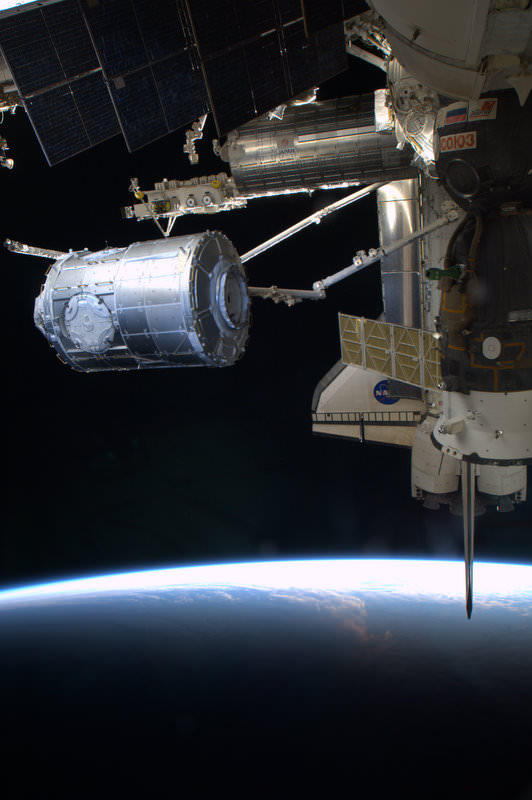
[/caption]
(Editor’s Note: Ken Kremer is at the Kennedy Space Center for Universe Today covering the flight of Endeavour)
The new 15 ton Tranquility module which had been carefully nestled and carried to orbit inside the cavernous payload bay of shuttle Endeavour, was bolted onto the left side port of the centrally positioned Unity module of the International Space Station (ISS) early this morning (Feb 12) at 12:20 AM EST during the first of three spacewalks (EVA’s) set for the STS 130 mission.
Installing the Tranquility life support module to the ISS was the primary task for the combined STS 130 and resident ISS crew of 11 people during the planned 13 day flight of Endeavour.
Tranquility was built in Italy by Thales Alenia for ESA and handed over to NASA in a barter exchange whereby NASA would launch ESA’s Columbus science lab module to orbit aboard the shuttle.
According to plan, EVA-1 Spacewalkers Nicholas Patrick and Bob Behnken departed outside via the stations Quest Airlock. Their first tasks were to prepare the way for unloading Tranquility from the payload bay by removing eight contamination covers from the berthing port on Tranquility, which will be attached to the Unity Node, and also opening a flap on Unity’s centerline camera which was then utilized to precisely line up and guide the two nodes during installation.
Astronauts Terry Virts and Kay Hire then deftly plucked Tranquility out from Endeavour’s payload bay using the stations robotic arm (SSRMS) and methodically attached it to Unity as astronauts Behnken and Patrick worked elsewhere to modify a tool platform on the Dextre special purpose dexterous manipulator. Leak checks confirmed the successful docking of the two nodes.
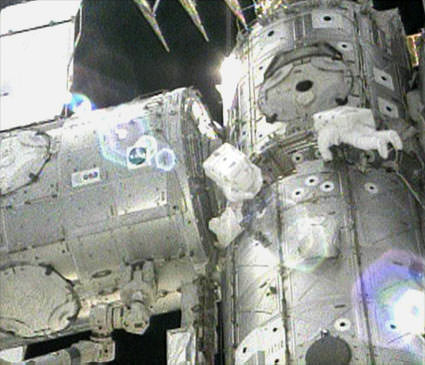
Patrick and Behnken then returned to Tranquility after it was in place and hooked up the crucial power and avionics cables between both nodes to provide a temporary power supply to run heaters on Tranquility. Additional cabling and coolant lines will be installed during the next spacewalk set for Saturday.
Watch for my upcoming report and pictures of the ammonia jumper hoses from KSC which had to redesigned and constructed in a race against time just before lift off after the original hoses failed preflight testing in January.
Behnken and Patrick completed their 6-hour, 32-minute EVA-1 spacewalk at 3:49 AM EST this morning and accomplished all their assigned tasks as well as some got ahead work !
Tranquility’s hatch is scheduled to be opened at about 9:14 PM tonight.
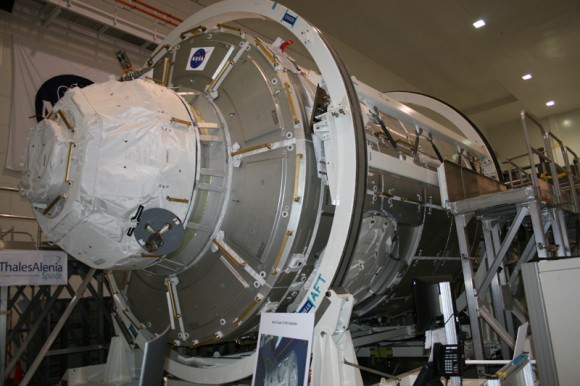
EVA-1 was the 138th in support of ISS assembly and maintenance, totaling 861 hours, 34 minutes. It was the 110th spacewalk out of the space station, totaling 674 hours, 19 minutes.
Tranquility is the final major US segment to be attached to the gigantic orbiting outpost, which spans the length of a football field. The combined weight of the ISS and shuttle exceeds 1 million pounds for the first time. Construction of the ISS is now over 90% complete.
Tranquility will house “many of the stations critical life support systems”, says Mike Suffredini, who is the lead manager of the ISS for NASA. Tranquility is outfitted with environmental control equipment for revitalizing the station atmosphere and removing contaminants, generating oxygen and providing breathable air, carbon dioxide removal, recycling waste water into potable drinking water, the crew toilet and the Colbert Treadmill for crew exercise. Suffredini told me in a prior interview that, “Many of the Tranquility racks are already aboard the ISS in the Destiny module and just need to be moved and installed. Their relocation will free up research space in Destiny”.
Earlier STS 130/ISS and SDO articles by Ken Kremer
Sky on Fire as Endeavour Blasts to Space
Orion can Launch Safely in 2013 says Lockheed
Russian Cargo Freighter Docks at ISS; 1 Day to Endeavour launch
Endeavour astronauts arrive at Cape for launch of Tranquility
ISS Crew Twitpics from Orbit; Live Streaming Video Soon !
Path clear for STS 130 to attach Tranquility module
Endeavour aiming for on time launch with coolant hose fix ahead of schedule
STS 130 flight pressing forward to launch as NASA resolves coolant hose leak
STS-130 Shuttle flight facing delay due to Payload technical glitch
Shuttle Endeavour Rolled to Pad; Countdown to the Final Five Begins
Best. Shuttle Image. Ever
[/caption]
While watching space shuttle Endeavour approach the International Space Station late Tuesday/early Wednesday, there was an amazing view shown on NASA TV, and I only hoped that someone on the ISS captured it with a high-resolution photo. They did. This amazing image shows Endeavor silhouetted against the tiny, colorful sliver of Earth’s atmosphere. Where else can you get an image like this except in space?! Incredible!
And below is the flipside, the view the space shuttle astronauts had of the ISS as they got closer to their new home in space.
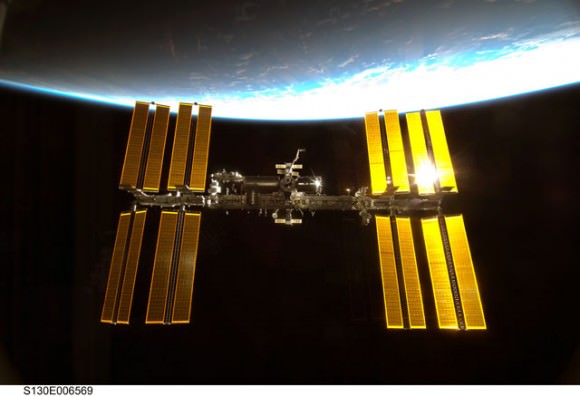
Check out all the images from the STS-130 mission and the ISS at the NASA Human Spaceflight website.
Thanks to @absolutspacegrl for posting this on Twitpics
On New Year’s Eve, Cassini Will Stare at the Death Star’s Superlaser
OK, it’s actually the Herschel crater on Mimas, a smallish moon of Saturn (and it’s the eve of Chinese New Year, February 13th, 2010), but it’s a cool headline, don’t you think?
Cassini will be very busy that day, which begins with a rare sunrise – the Sun goes behind Saturn (from Cassini’s perspective) – followed by a rare blackout, as the Earth goes behind Saturn. Then there’s three “Forward shields up!” moments, as Cassini tries to dodge a Klingon missile flies through regions of “increased ring particle concentration”, a couple of distant flybys (Epimetheus, Janus; ~100,000 km each), a ring-plane crossing, another “Shields up!” moment, and a 9,500 km close approach to Death Star Mimas. And the day ends with a distant (112,000 km) flyby of Tethys. Whew!
“Mimas bears the mark of a violent, giant impact from the past – the 140-kilometer-wide Herschel Crater – and scientists hope the encounter will help them explain why the moon was not blown to smithereens when the impact happened. They will also be trying to count smaller dings inside the basin of Herschel Crater so they can better estimate its age,” JPL’s Jia-Rui C. Cook said, “The Mimas flyby involves a significant amount of skill because the spacecraft will be passing through a dusty region to get there. Mission managers have planned for the Cassini spacecraft to lead with its high-gain antenna to provide a barrier of protection.”
To date, the best images of Mimas – and its Herschel crater – were obtained on August 2nd, 2005, during Cassin’s distant flyby.
Mimas is an inner moon of Saturn that averages 396 kilometers in diameter. The diameter of Herschel Crater is about one-third that of the entire moon. The walls of the crater are about 5 kilometers high, and parts of the floor are approximately 10 kilometers deep.
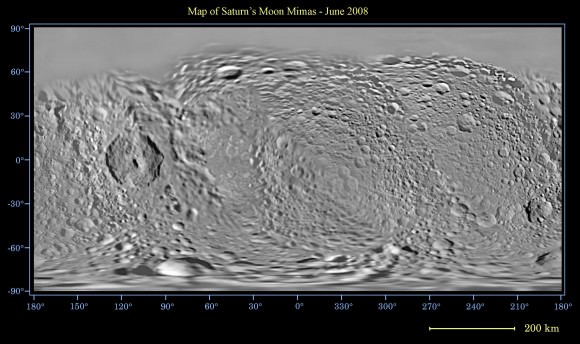
Mimas would have beaten another of Saturn’s moons, Rhea, for the record of “most battered moon”, but for the fact that it was warmer – and so softer – for longer than Rhea (because it’s closer to Saturn), so many of the earliest craters were more degraded.
Have you heard of the “Mimas paradox”? Mimas’ orbit is more eccentric than Enceladus’, and is in resonance with Dione and Enceladus – so it should be heated, tidally, more than Enceladus – but its surface has not, apparently, changed for a very long time (while geysers on Enceladus show that it is still quite active). Further, the two moons seem to have similar compositions.
On this flyby, Cassini’s composite infrared spectrometer will be working to determine the thermal signature of the moon, and other instruments will be making measurements to learn more about the surface composition. Perhaps that will shed some light on the Mimas paradox.
Sources: Cassini Set to Do Retinal Scan of Saturnian Eyeball, Mimas (NASA/JPL)

